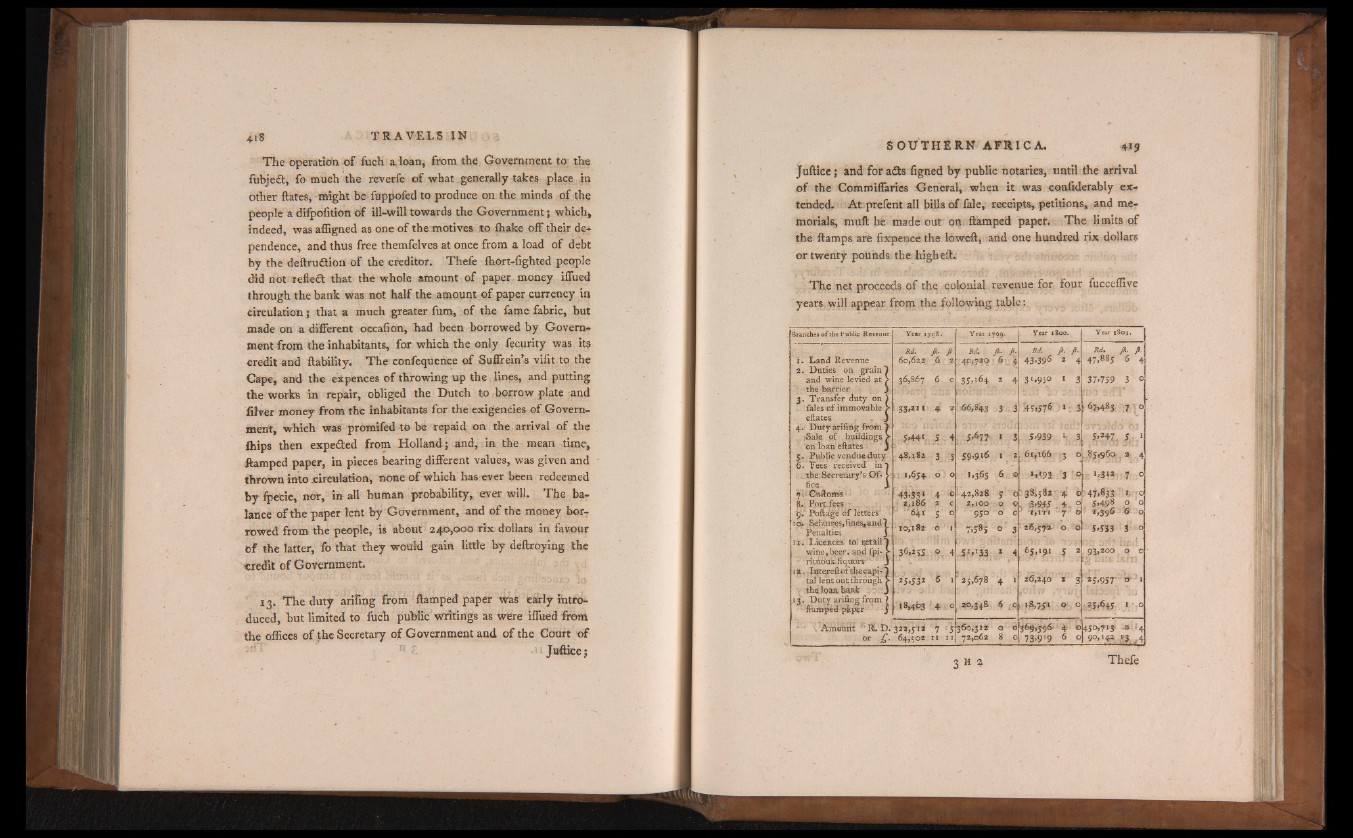
The operation of fuch a loan, from, the Government to the
fubjeft, fo much the reverfe of what generally takes place in
other ftates, might be fappofed to produce on the minds of the
people a difpofition of ill-will towards the Government; which,
indeed, was affigned as one of the motives to ihake off their dependence,
and thus free themfelves at once from a load of debt
by the deftrufiion of the creditor. Thefe Ihort-fighted people
did not reflea that the whole amount of paper money iffued
through the bank was not half the amount of paper currency in
circulation} that a much greater furn, of the feme fabric, but
made on a different occafion, had been borrowed by Government
from the inhabitants, for which the only fecurity was its
credit and liability. The confequence of Suffrein’s vifit to the
Gape, and the expences of throwing up the lines, and putting
the works in repair, obliged the Dutch to borrow plate and
filver money from the inhabitants for the exigencies of Government,
which was promifed to be repaid on the arrival of the
fhips then expected from Holland} and, in the mean time,
damped paper, in pieces bearing different values, was given and
thrown into circulation, none of which has ever been redeemed
by fpecie, nor, in all human probability, ever will. The balance
ofthe paper lent by Government, and of the money borrowed
from the people, is about 240,000 rix dollars in favour
of the latter, fo that they would gain little by deilroying the
«redit of Government.
13. The duty ariling from ftamped paper was early introduced,
hut limited to fuch public writings as were iffued from
the offices of.thc Secretary of Government and of the Court of
Juftice;
jfuftice} and for a£ts figned by public notaries, until the arrival
of the Commiffaries General, when it was caniiderably extended.
At prefent all bills of fele, receipts, petitions, and memorials,
muft be made out on ftamped paper. The limits of
the ftamps are fixpence the loweft, and one hundred rix dollars
or twenty pounds the higheft.
The net proceeds of the colonial.revenue for four fucceffive
years will appear from the following table:
Branches of the Public Revenue. Year 1798.
1. Land Revenue
2. Duties on grain")
and wine levied at >
the barrier y
3. Transfer duty on )
. fales o f immovable >
eftates - 3
4. Duty ariiirig fro*i J
¡Sale of buildings >
oh 'loan eftates 1 3
5. Public vendue duty
0. Fees-received m l
the Secretary’s Of- >
fic^. 3
•jl - Guftoros ■ >
Pp^f.f?es -
g . P o fta g c i o f l6 tt^ r§ J V
ipk Seixui^Sjftnes^and)
Penalties y
11. Licences to ^etailT
wine^beer, and fpi- >
® Htdo'U^HquotS''' ‘ j
12. Intereftofthecapi-)
tal lent out tnrougli >
the lorn hank j
13. Duty arifing from ?
ffampeif pfipelr j
Rd. Jk. JÏ
60,62% 6 2
36,867 6. c
53,in 4 ?
5*44* 5
48.182 3
1.1,654 o
45*35-* 4
r 2,186 2
1 5
10.182 o
36.255 0
25.532 6
«*rfP3 4
. Aincfàttt 1 RLD. 322,512 <7
or £ . 64,502 11
R d , Jk.
_4P>7<*® • 6
35,164. 2
66,843 j
5.477 •
59.916 i
1.363 6
42,82ft 5
2,100 T,<^
950 a
7.5*5 o
0 % *
25,678 4
20,348 6
360*3 *2 a
72,062 8 o
Rd. J . j
43.396 *
3'.930 >
45.376 >
5-939 w
6itï66 3
M 93 '3
38Ì5S2 4!
, 3,945 , 4 i,,¥i t .
M. jk. Jk.
47,885 6 4
37,759 3 o
67,483 7 o
5>24r Sy.1
85,960. 2 4
B 1 ,3 « 7 o
47»$$ '*• 'O
5,498 o o
1,396 6 o
2 6,5^ o * 5>SS3 r o
65. >91 5
93,200 o o
*5*957’ & *
26,240 2
1&75& q> i-o
369.556- 4
73-9 '9 6
0450,7.3 -a .4
O] 9 0 ,1 4 ^ I f f 4
111